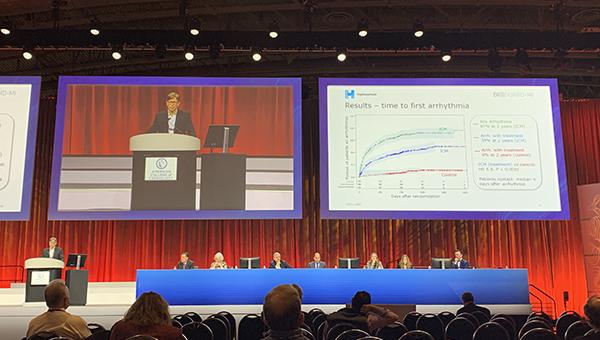BIO|GUARD-MI: Post-MI Arrhythmia Monitoring Falls Short
Despite the negative result, “the concept, I think, is one of value,” Deepak Bhatt says, calling for additional studies.

WASHINGTON, DC—Using an implantable cardiac monitor (ICM) to look for arrhythmias after an MI—and initiate treatment as appropriate—does not provide a significant clinical benefit, according to the results of the BIO|GUARD-MI trial.
Compared with usual follow-up, routine monitoring led to more arrhythmias being picked up and treated, but it did not ultimately reduce the risk of CV mortality or hospitalization for various causes through 2 years (HR 0.84; 95% CI 0.64-1.10).
There was, however, a hint that the approach could improve outcomes in the roughly half of patients who had had an NSTEMI, Christian Jons, MD, PhD (Rigshospitalet, Copenhagen, Denmark), reported recently at the American College of Cardiology (ACC) 2022 Scientific Session.
“This benefit appeared to be a result of the higher risk in the NSTEMI group,” he said.
Commenting for TCTMD, Deepak Bhatt, MD (Brigham and Women’s Hospital, Boston, MA), said the trial provides a “glimpse of the future” in which high-risk patients are monitored in some way to look for treatable conditions, a strategy that “makes a lot of intuitive sense.” He noted that there is some precedence, pointing to the CardioMEMS system (Abbott) for patients with heart failure.
Even though BIO|GUARD-MI did not demonstrate a benefit when using an ICM, “the concept, I think, is one of value,” Bhatt said, adding that it’s worth pursuing further in a study with more patients and longer follow-up.
Post-MI Arrhythmia Monitoring
Arrhythmias worsen outcomes after an MI, Jons said. Implantable devices can detect a large burden of asymptomatic rhythm disturbances, which are also tied to poorer outcomes, he added. No prior trials, however, have tested whether monitoring for and treating these arrhythmias can is beneficial.
The BIO|GUARD-MI trial, conducted at 60 sites across Europe, the United States, and Australia, was designed to do just that. Investigators enrolled 790 patients (mean age 72 years; 72% men) who had had an MI and were deemed to be a high risk by virtue of an elevated CHA2DS2-VASc score (≥ 4 for men and 5 for women), randomizing them to ICM implantation plus telemonitoring or standard follow-up. Patients who had known atrial fibrillation or an indication for an implantable cardioverter-defibrillator, cardiac resynchronization therapy, or pacemaker were excluded.
Slightly more than half of the participants (51%) had had an NSTEMI, with STEMI in the rest. The MI had occurred within the last 40 days in 35%. Average LVEF was 53%.
Over the course of 2 years, any arrhythmia was detected in 67% of patients in the ICM group. The rate of treated arrhythmias was significantly higher in the ICM versus standard group (39% vs 6%; HR 5.9; P < 0.0001). The most common treatments applied in the ICM group were oral anticoagulation (40%), pacemakers (20%), and beta-blocker dose adjustments (decrease in 18% and increase in 7%).
The primary endpoint was a composite of CV mortality or hospitalization for arrhythmia, ACS, worsening heart failure, stroke, systemic embolism, or major bleeding. There appeared to be an emerging separation in event rates between the two trial arms—favoring ICM implantation—by 2 years, though the difference did not reach statistical significance.
A prespecified subgroup analysis suggested a differential impact in NSTEMI and STEMI patients (P = 0.09 for interaction), with a significant decrease in primary endpoint events with arrhythmia monitoring in the NSTEMI group (HR 0.69; 95% CI 0.49-0.98) but not the STEMI group (HR 1.10; 95% CI 0.72-1.69).
Jons reported that NSTEMI patients had a greater risk of events compared with their counterparts with STEMI (HR 1.75; 95% CI 1.33-2.30), and that a separate multivariate analysis indicated high-risk patients in general had a reduction in adverse outcomes with arrhythmia monitoring.
Calling for Further Studies
Discussing the results at a press briefing, Roxana Mehran, MD (Icahn School of Medicine at Mount Sinai, New York, NY), pointed out that the trial, which was stopped early, was underpowered due to fewer-than-anticipated endpoint events. Thus, she urged additional large prospective studies to evaluate the potential impact of monitoring, particularly in the NSTEMI group.
“To me, it’s a very important study and it makes you think that maybe we’re missing a lot of events” by not monitoring, Mehran said.
In the future, Bhatt said, monitoring for arrhythmias and other potentially actionable findings after a procedure or an event like an MI might be done through the use of wearable devices like smartwatches, which continue to grow in popularity. How this deluge of data will be managed by the healthcare system remains unclear, he indicated. But “I imagine in a few years all of this will come together and this sort of monitoring post-procedure or post-heart attack or post-stroke, or whatever the disease condition might be, will increase,” he said, referring to monitoring initiated by patients.
And, if supportive data emerge, physicians may also start recommending monitoring in select cases, Bhatt said.
For now, he said, “I don’t think these data are actionable, . . . but I think it should prompt a larger study of NSTEMI, and I would say even the STEMI patients, to see if there really is anything to this approach.”
Todd Neale is the Associate News Editor for TCTMD and a Senior Medical Journalist. He got his start in journalism at …
Read Full BioSources
Jons C. BIO|GUARD-MI: biomonitoring in patients with preserved left ventricular function after diagnosed myocardial infarction. Presented at: ACC 2022. April 4, 2022. Washington, DC.
Disclosures
- Jons reports consultancy agreements with Abbott and Biotronik.
- Bhatt reports receiving research funding or unfunded research support from Abbott, Amarin, Amgen, AstraZeneca, Bayer, Boehringer Ingelheim, Bristol-Myers Squibb, Chiesi, Eisai, Ethicon, Forest Laboratories, Idorsia, Ironwood, Ischemix, Lilly, Medtronic, PhaseBio, Pfizer, Regeneron, Roche, Sanofi, Synaptic, The Medicines Company, FlowCo, Merck, Novo Nordisk, PLx Pharma, and Takeda; being a site co-investigator for Biotronik, Boston Scientific, St. Jude Medical, and Svelte; being a trustee for ACC; serving as an advisory board member, director, or chair for Cardax, Elsevier Practice Update Cardiology, Medscape Cardiology, Regado Biosciences; the Boston VA Research Institute, the Society of Cardiovascular Patient Care, TobeSoft; the American Heart Association Quality Oversight Committee; serving on a range of data safety monitoring committees; receiving honoraria for editorial or committee activities for a range of publications and organizations; and receiving royalties from Elsevier.




Comments